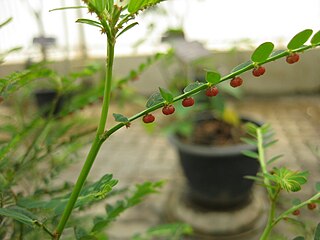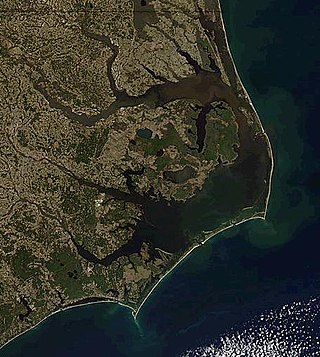
Spanish moss is an epiphytic flowering plant that often grows upon large trees in tropical and subtropical climates. It is native to much of Mexico, Bermuda, the Bahamas, Central America, South America, the Southern United States, and West Indies. It has been naturalized in Queensland (Australia). It is known as "grandpa's beard" in French Polynesia.

The Eastern United States, often abbreviated as simply the East, is a macroregion of the United States located to the east of the Mississippi River. It includes 17–26 states and Washington, D.C., the national capital.

The Southeastern United States, also referred to as the American Southeast, the Southeast, or the South, is a geographical region of the United States located in the eastern portion of the Southern United States and the southern portion of the Eastern United States. The region includes a core of states that reaches north to Maryland and West Virginia, bordering the Ohio River and Mason–Dixon line, and stretches west to Arkansas and Louisiana.

Sabal minor, commonly known as the dwarf palmetto, is a small species of palm. It is native to the deep southeastern and south-central United States and northeastern Mexico. It is naturally found in a diversity of habitats, including maritime forests, swamps, floodplains, and occasionally on drier sites. It is often found growing in calcareous marl soil. Sabal minor is one of the most frost and cold tolerant among North American palms.

Phyllanthus is the largest genus in the plant family Phyllanthaceae. Estimates of the number of species in this genus vary widely, from 750 to 1200. Phyllanthus has a remarkable diversity of growth forms including annual and perennial herbs, shrubs, climbers, floating aquatics, and pachycaulous succulents. Some have flattened leaflike stems called cladodes. It has a wide variety of floral morphologies and chromosome numbers and has one of the widest range of pollen types of any seed plant genus.

Phyllanthus urinaria, commonly called chamber bitter, gripeweed, shatterstone, stonebreaker or leafflower, is a species of suffruticose plant in the family Phyllanthaceae.

Andrachne is a genus of flowering plants in the family Phyllanthaceae described by Linnaeus in 1753. It is one of eight genera in the tribe Poranthereae.

Xerophyllum asphodeloides is a North American species of flowering plants in the Melanthiaceae known by the common names turkey beard, eastern turkeybeard, beartongue, grass-leaved helonias, and mountain asphodel. It is native to the eastern United States, where it occurs in the southern Appalachian Mountains from Virginia to Alabama, and also in the Pine Barrens of New Jersey.

The Outer Banks are a 200 mi (320 km) string of barrier islands and spits off the coast of North Carolina and southeastern Virginia, on the east coast of the United States. They line most of the North Carolina coastline, separating Currituck Sound, Albemarle Sound, and Pamlico Sound from the Atlantic Ocean. A major tourist destination, the Outer Banks are known for their wide expanse of open beachfront and the Cape Hatteras National Seashore. The seashore and surrounding ecosystem are important biodiversity zones, including beach grasses and shrubland that help maintain the form of the land.

Anartia jatrophae, the white peacock, is a species of butterfly found in the southeastern United States, Central America, and throughout much of South America. The white peacock's larval hosts are water hyssop, lemon bacopa, tropical waterhyssop, frogfruit, lanceleaf frogfruit, and Carolina wild petunia . The males of the species display a unique territorial behavior, in which they stake out a territory typically 15 meters in diameter that contains larval host plants. They perch in this area and aggressively protect it from other insects and other male white peacocks.

Sabal palmetto, also known as cabbage palm, cabbage palmetto, sabal palm, blue palmetto, Carolina palmetto, common palmetto, Garfield's tree, and swamp cabbage, is one of 15 species of palmetto palm. It is native to the far Southeast United States, the Yucatán Peninsula in Mexico, the West Indies, and the Bahamas.

Myrica cerifera is a small evergreen tree or large shrub native to North and Central America and the Caribbean. Its common names include southern wax myrtle, southern bayberry, candleberry, bayberry tree, and tallow shrub. It has uses in the garden and for candlemaking, as well as a medicinal plant.

Ruellia caroliniensis, the Carolina wild petunia, is a wild petunia with blue or violet flowers that appear in the spring, summer, and autumn. Its leaves are light green. This species is native to the southeastern United States.

Trautvetteria caroliniensis is a species of flowering plant in the family Ranunculaceae native to North America. It is known by the common names Carolina bugbane, false bugbane, and tassel-rue. The genus is named for the botanist Ernst Rudolf von Trautvetter.

Frasera caroliniensis, commonly known as American columbo or yellow gentian, is a herbaceous perennial of the gentian family Gentianaceae found in the deciduous forest of Southern Ontario and throughout the eastern and southeastern United States. It was previously known as Swertia caroliniensis.

Myrica caroliniensis is a shrub or small tree native to the coast and coastal plains of southeastern North America. Its common names include bayberry, southern bayberry, pocosin bayberry, and evergreen bayberry. It sees uses in the garden and for candlemaking, as well as a medicinal plant.

Phyllanthus abnormis, known as Drummond's leafflower, is an herbaceous plant in the family Phyllanthaceae. It grows from 10 to 50 centimeters in height. It is native to the United States and Mexico (Tamaulipas). Throughout its range, it is always found growing in sand or sandy soil.

Phyllanthus polygonoides, known as smartweed leaf-flower or knotweed leafflower, is an herbaceous perennial plant in the family Phyllanthaceae. It grows from 10 to 50 centimeters in height. It is native to the United States and northern and central Mexico.

Phyllanthus tenellus is a herbaceous plant in the leafflower family, Phyllanthaceae. It is commonly called Mascarene Island leaf flower as it is native to the Mascarene Islands. It is often a weed in flower beds, gardens, roadsides, and other disturbed areas.

Phyllanthus fluitans, also known as the red root floater, floating spurge, or apple duckweed is a species of free floating aquatic plant and herbaceous perennial in the family Phyllanthaceae. This species is one of the only three non-terrestrial species in the genus Phyllanthus, with the other species being P. leonardianus and P. felicis. The generic name comes from Ancient Greek meaning leaf or a leaf flower, and the specific name comes from Latin meaning floating or float. It was described in March 1863 by George Bentham and Johannes Müller Argoviensis.




















